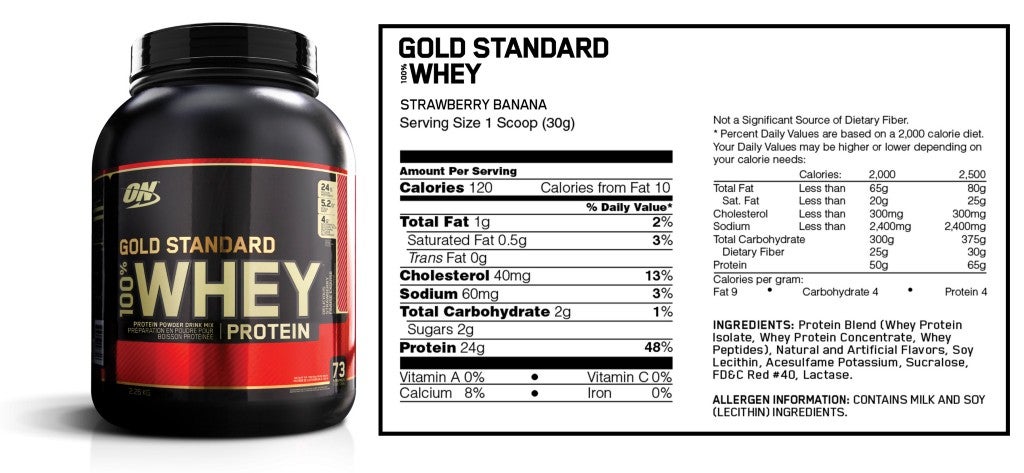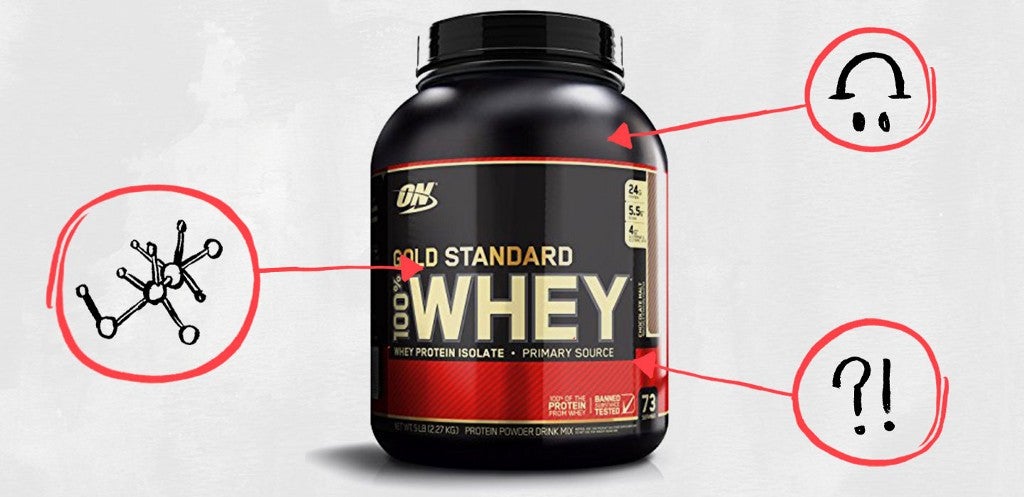We’re often told that you should never eat anything if you don’t recognize everything on the ingredients list. But since most of us have no idea what xanthan gum and potassium benzoate are — or, more importantly, what they’re doing to our bodies — we’re decoding the ingredients in the many things Americans put in (and on) themselves with the help of an expert. This edition: Strawberry-Banana-Flavored Optimum Nutrition Gold Standard 100% Whey Powder, which is made from eight separate ingredients that we’ve broken down in the exact order they appear on the tub.


The Ingredients
1) Protein Blend (Whey Protein Isolate, Whey Protein Concentrate, Whey Peptides): The three separate ingredients found in this protein blend are simply different forms of whey protein (that is, the protein-packed leftovers of cheese production). Each serves a slightly different purpose, according to Dagan Xavier, ingredient expert and co-founder of Label Insight: Whey protein isolate contains more protein but less sugar and fat; whey protein concentrate contains less protein but more whole nutrients; and whey peptides are essentially stripped-down proteins that aid with post-workout recovery. Tons of popular protein supplements incorporate whey protein (NytroWhey Ultra Elite, MyProtein Impact Whey and MuscleTech Performance Series Nitro-Tech chief among them), since it’s been shown to reduce body fat and contribute to muscle growth.
“As a pre-or-post-workout fuel, whey is just fine,” says board-certified nutrition specialist Jason Boehm. “But I’m not a big fan of whey as a meal-replacement powder, because it’s quickly absorbed, meaning it’s not very filling.”
In other words, don’t expect a scoop of this stuff to transform your post-workout shake from a small snack to a satisfying lunch, or you’ll be left disappointed and hungry.
2) Natural and Artificial Flavors: These are the culprits behind this powder’s strawberry-banana flavor. While natural flavors are literally flavors derived from an actual food source — i.e., strawberry flavoring taken from a real strawberry — artificial flavors are chemical compounds created in a lab that mimic a natural flavor in some way. While that may sound unhealthy, as physician and biochemist Cate Shanahan, author of Deep Nutrition: Why Your Genes Need Traditional Food, told us during our exploration of all 26 ingredients in nacho-flavored Doritos, these flavorings are added in such small quantities that they shouldn’t cause you any harm.
3) Soy Lecithin: Soy lecithin is a component of fat found in (you guessed it!) soy. It’s typically added to food products as an emulsifier: In simpler terms, it’s what allows this powder to dissolve evenly when added to water (or whatever beverage you prefer), rather than forming tiny, protein-laden icebergs. “It’s also frequently used to extend product shelf life,” Xavier adds. Boehm also says that unless you have an extreme allergy to soy — which you’d know by now — soy lecithin isn’t anything to worry about.
4) Acesulfame Potassium: Acesulfame potassium is an artificial sweetener, and as we learned in our analysis of the eight ingredients in Diet Coke, artificial sweeteners suck for a few reasons. Not only do they promote weight gain (visit the link above for an in-depth explanation on how that works) — despite being marketed as doing the very opposite — recent rodent studies also suggest that long-term consumption of acesulfame potassium may cause cognitive damage. That said, as with all rodent studies, further research is required to fully understand the effects this ingredient has on humans.
5) Aminogen: “Aminogen is an enzyme sometimes added to whey products to speed up digestion,” Boehm explains. “Studies show it’s safe, but I don’t think it’s necessary to add to whey powders, since they absorb well enough on their own.” Either way, this ingredient is added to keep those dreaded “protein poops” at bay, and as Xavier explains, “to aid the breakdown and absorption of excess protein in order to help with muscle development, strength and recovery.”
6) Sucralose: This is yet another artificial sweetener, more commonly known as Splenda. In addition to all the other problems posed by artificial sugars, studies suggest that sucralose in particular increases the populations of bacteria in our gut that pull energy from our food and turn that energy into fat. That is to say, sucralose may make us fat.
7) FD&C Red #40: This artificial color, like many of them, is known to be carcinogenic. That said, as Cate Shanahan explained during our analysis of Doritos, studies arguing this are a bit flawed:
“I’ve always been of the opinion that studies claiming artificial colors can cause cancer are irrelevant because [in the studies] they use really high amounts of the artificial colors — like, a million times more than you’d ever get [in your] food [throughout your lifetime].”
All in all, the average person’s liver should be able to break down whatever minuscule amount of artificial coloring we consume with food (or the protein powder we’re chugging instead of food).
8) Lactase: According to Boehm, lactase is an enzyme that breaks down lactose (the sugar found in dairy). It’s likely added to help our digestive system break down the dairy-packed whey found in this powder.
The Takeaway
Optimum Nutrition Gold Standard 100% Whey Powder contains a few potentially harmful ingredients, acesulfame potassium and sucralose chief among them. Combine that with the fact that Americans already consume way too much protein, and this product just doesn’t seem worth it. If you want to see better results from your workout, you’re better off just eating right and shaving off all your body hair, which apparently has the same effect.

